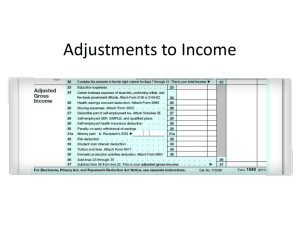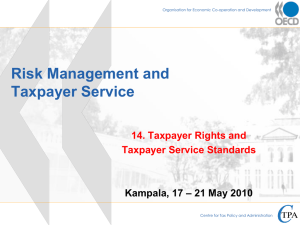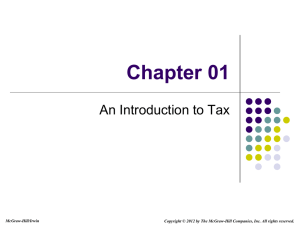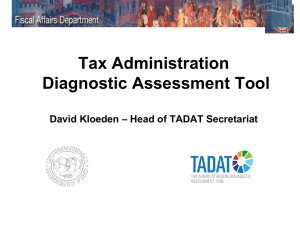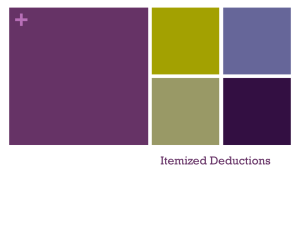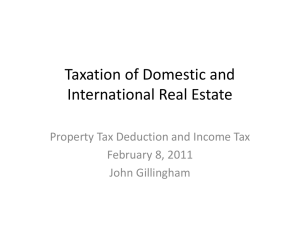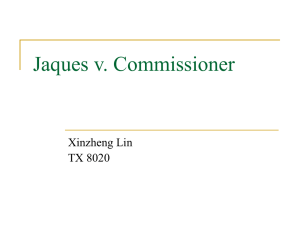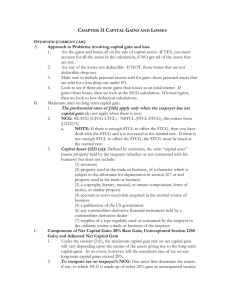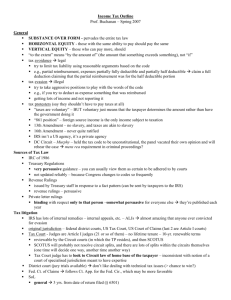Adjustment () - Grace College and Seminary
advertisement
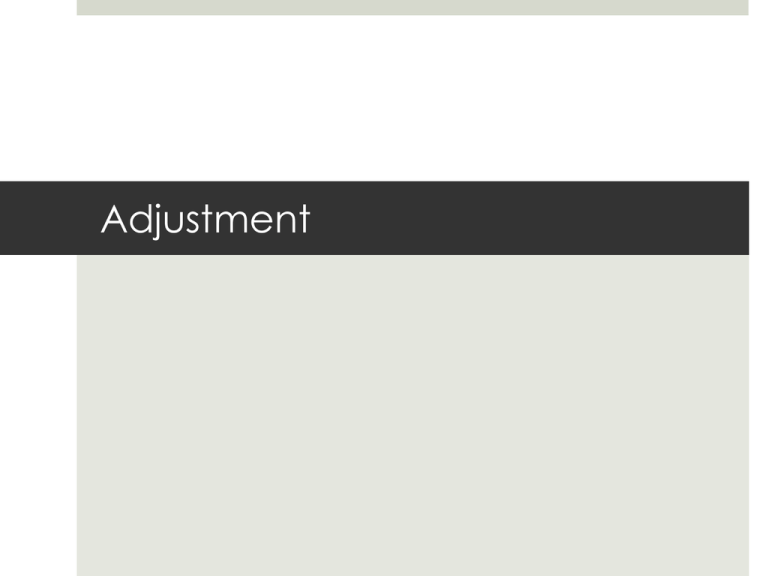
Adjustment Adjustment to Income Taxpayers can subtract certain expenses, payments, contributions, fees, etc. from their total income. The adjustments subtracted from total income on Form 1040 establish the AGI. The line items under the Adjusted Gross Income section of the tax return are all Intermediate topics, except the penalty on early withdrawal of savings, which is a Basic topic. One half of self employment tax Self-employed taxpayers can subtract half of their selfemployment tax from their income. This is equal to the amount of social security tax and Medicare tax that an employer pays for an employee, which is excluded from an employee's income. Form 1099-INT Taxpayers can adjust their income by deducting penalties they paid for withdrawing funds from a deferred interest account before maturity. Ask if the taxpayer and/or spouse made any early withdrawals during the tax year. If so, ask to see Form 1099-INT, Interest Income, or Form 1099-OID, Original Issue Discount, documenting the penalty. Example A penalty for early withdrawal of funds from a savings account may be charged when the depositor withdraws funds _____. a. From an ordinary savings account b. Before a certain amount of interest accumulates c. Before the maturity date for a time deposit d. Any of the above Alimony Alimony is a payment to a spouse or former spouse under a divorce or separation instrument. The payments do not have to be made directly to the ex-spouse. For example, payments made on behalf of the ex-spouse for expenses specified in the instrument, such as medical bills, housing costs, and other expenses can qualify as alimony. Alimony does not include child support or voluntary payments outside the instrument. The person paying alimony can subtract it as an adjustment to income the person receiving alimony must treat it as income. Example Anthony has been divorced for three years. Under his divorce instrument, he paid his ex-wife $12,600 in 2010. As a favor, he also made $2,400 in payments to cover part of her vehicle lease so she could keep steady employment. Anthony can take the $12,600 as an adjustment to income. He cannot count the lease payments because those payments were not required by the divorce instrument. Example Victoria divorced in 2007. Her settlement agreement states that she must pay her ex-husband $16,000 a year. She is also required to pay his ongoing medical expenses for a condition he acquired during their marriage. In 2010, the medical expenses were $9,500. How much can she deduct as an adjustment to income? a. $16,000 b. $9,500 c. $25,500 d. $6,500 IRA Deduction Deductible vs Non Deductible Contribution Deductible – all distributions will be taxed unless taxpayers can show, with satisfactory evidence, that they made nondeductible contributions. Non-Deductible – IRA Contribution is funded with after-tax money. Taxpayer must file Form 8606 to declare Non-Deductible contributions. This is out of scope for VITA IRA Deduction To determine the traditional IRA deduction amount for taxpayers covered by an employer's retirement plan, refer to the traditional IRA deduction phase out chart Student Loan Interest The student loan interest deduction is generally the smaller of $2,500 or the interest paid that year on a qualified student loan. This amount is gradually reduced (phased out) or eliminated, based on the taxpayer's filing status and MAGI. Who Can Claim the Deduction? The taxpayer cannot use Married Filing Separately status; married taxpayers must file a joint return with their spouse The taxpayer cannot be claimed as a dependent on someone else's return The taxpayer is legally obligated to pay interest on a qualified student loan The taxpayer paid interest on a qualified student loan The interest is on a loan used to pay tuition and other qualified higher education expenses for the taxpayer, the taxpayer's spouse, or someone whom the taxpayer claimed as a dependent, when the loan was taken out The education expenses were paid or incurred within a reasonable period of time before or after the loan was taken out Q&A Question: Can taxpayers who were dependents when they took out their student loan start to deduct student loan interest after they are no longer a dependent? Answer: Yes. Although dependent taxpayers cannot claim the deduction, they can deduct interest payments made in later years when they can no longer be claimed as a dependent. Example Todd and Janet have a MAGI of $45,000. They are married and file a joint return. Two years ago, they took out a loan so Todd's mother could earn her RN degree at night school. Todd could not claim her as a dependent on his return. In 2010, they paid $1,000 in interest on the loan. How much can they deduct from their income? a. $0 b. $1,000 c. $1,500 d. $2,500 Eligible Education Institution A college, university, vocational school, or other postsecondary educational institution eligible to participate in Department of Education student aid programs. This category includes virtually all accredited public, nonprofit, and privately owned profit-making postsecondary institutions. An institution conducting an internship or residency program leading to a degree or certificate from an institution of higher education, a hospital, or a healthcare facility that offers postgraduate training. Eligible Student An eligible student is someone who is enrolled at least half-time in a program leading to a degree, certificate, or other recognized educational credential. The standard for what is half the normal full-time work load is determined by each eligible educational institution. Reporting If the taxpayer paid $600 or more in interest to a single lender, the taxpayer should receive Form 1098-E, Student Loan Interest Statement, or another statement from the lender showing the amount of interest paid. Student loan interest is reported on Form 1098-E, box 1 The deductible amount is calculated using the Student Loan Interest Deduction Worksheet.

